Goniurosurus also known as “cave geckos” are a small, terrestrial gecko native to China, Japan and Vietnam. With their bright colors (which I think makes them look like psychedelic leopard geckos) and red eyes, they are striking to look at and tempting to own. This opinion is borne out by what our three experts of the month have to say about Goniurosuarus.
As always, the responders answered the following five questions:
What species are you keeping?
What got you interested in this species and where did you get your first one(s)?
How are they set up? Describe your enclosure
What do you find most interesting about them?
What do you find to be the biggest challenge?
Carola Jucknies
I currently keep Goniurosaurus hainanensis, Goniurosaurus lichtenfelderi, Goniurosaurus luii, Goniurosaurus araneus, Goniurosaurus catbaensis, Goniurosaurus bawanglingensis, Goniurosaurus huuliensis, Goniurosaurus orientalis, Goniurosaurus splendens, Goniurosaurus yamashinae, and Goniurosaurus kuroiwae.
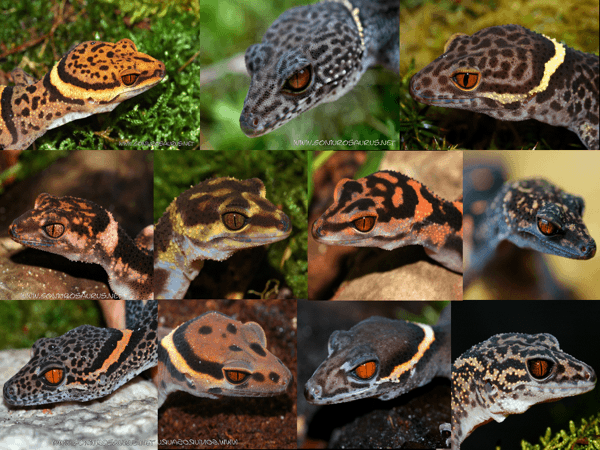
I first became interested in the genus Goniurosaurus in 2010 after reading an article about Goniurosaurus araneus by Andreas Dickhoff in a German reptile magazine called “DRACO” (Nr. 18 – Geckos) and was immediately fascinated by these beautiful, slender and amber eyed geckos. So, in March 2011, I bought my first three G. luii from a German breeder at the Hamm show. Goniurosaurus araneus, Goniurosaurus hainanensis and G. lichtenfelderi quickly followed. More and more I became “infected with the Goniurosaurus virus”. Most important for me was to find animals from diverse bloodlines. Not as easy as I thought. Within 3 years I built up breeding groups with animals I collected from breeders all over Europe (The Netherlands, Hungary, Poland, United Kingdom, Czechoslovakia). Today I keep 11 of 14 known species of this genus and I hope there’s a chance that I can also work with the 3 missing species ( G. toyamai, G. yingdeensis, G. liboensis) some day.
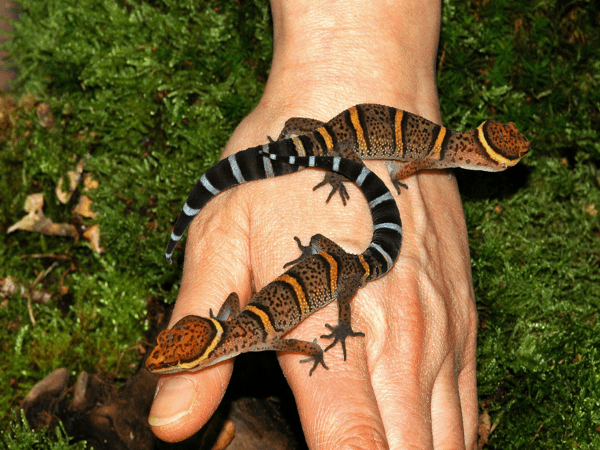
I keep the adult Goniurosaurus in Exo Terra Cages or custom made glass terrariums of different sizes. For the Japanese species a length of 45 to 60 cm seems to be adequate for 1-2 geckos; the members of the luii group prefer a length of 90 cm for a pair or a trio. All Goniurosaurus species climb well, so a background is essential. Goniurosaurus araneus, G. catbaensis and G. luii spend nearly their whole activity period on the background. They love to hunt from above. The set-up is something like a “semi-naturalistic-type” with coconut substrate, a moist hiding place, a climbing branch, a water dish and a
living plant.
I use T5 fluorescent tubes as daytime lighting for 12 hours in the summer and 8 hours in the winter period. Temperature is 24-26 degrees Celsius ( 75 – 79 degrees F.) in the daytime and 22 degrees C. ( 71 degree F.) during the night. In the winter the temperature is about 4 degrees C. ( 7 degree F.) lower. There is no additional heating necessary, because room temperature is generally between 25 -26 degrees C. (77 – 79 degree F.). The offspring are kept in a rack system under simple conditions. I use paper towels as bedding for the first 1-2 weeks, one or two hides and a waterdish. When the hatchlings eat well and digestion works, I use coconut substrate and add some cork bark for climbing.
Little is known about the genus Goniurosaurus in comparison to many other reptiles that are well established in herpetoculture. So it’s a very interesting thing for me to observe their behaviour and to find out data about egg incubation, size of the hatchlings and their development. Besides, it’s fascinating to have a look at these colourful geckos with their stunning red eyes . . . in those moments you can forget that there are any other reptiles at all.
My biggest challenge is to establish stable breeding groups of all species I’m keeping.In the long term I hope to get the opportunity to work with the newly described species and – finally, I’m planning to go to Asia to observe my favorite gecko genus in their natural habitat.
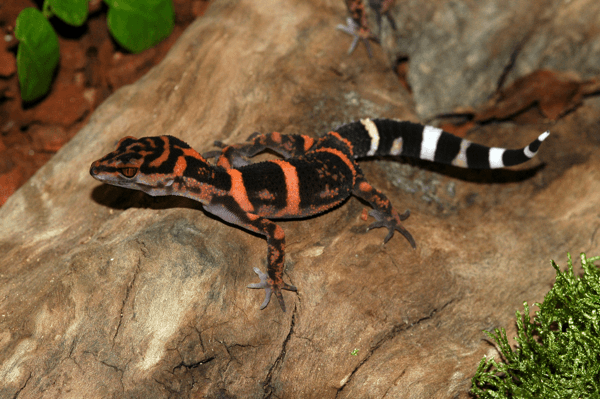
Derek Vera
I am currently keeping Goniurosaurus Hainanensis also known as the Chinese Cave Gecko. At this time I have 30 in my collection and welcomed my second generation of captive breds earlier this year.
I have kept and bred Leopard Geckos for 12 years and while doing research I came across a book called “The Eyelashgeckos”. After skimming through this book I read a lot about the Goniurosaurus species and hoped that one day I would be able to work with them. It was 2010 and I came across a classified add on Kingsnake for adult cave geckos. I jumped on the opportunity and ordered a trio.
I keep my hatchlings on moist paper towels in shoe box size sterilite containers. It is a very simple set-up with a single hide and a shallow water dish. My adults are kept in sweater box sterilite tubs on eco earth coco fiber with a few artificial plants, multiple hides, and a water dish. I keep my original trio in a naturalistic setup.
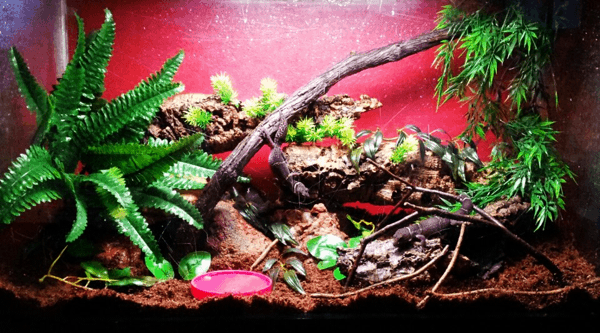
I love how personable this species is. They are very curious and are not afraid to stalk prey with me watching.
I can honestly say that I have not had a single challenge while keeping this species. You almost can’t go wrong! They are kept at room temperature (75-78) and eggs are also incubated at these temps.
Rachel Wintjen
For about four years now, I’ve considered myself an extreme gecko enthusiast. I dream about geckos, talk like a maniac about them, imagine
what I could do if I paired X with Y, and what the offspring may turn out to look like. Most of my friends have heard the spiel, and people who haven’t met me yet are usually in for a big surprise within ten minutes of doing so. My first gecko was a crested gecko purchased from a pet store. I bought a second one about a year later. They made babies, I freaked and started my research. Luckily crested geckos were easy to care for, and the babies were all beautiful.
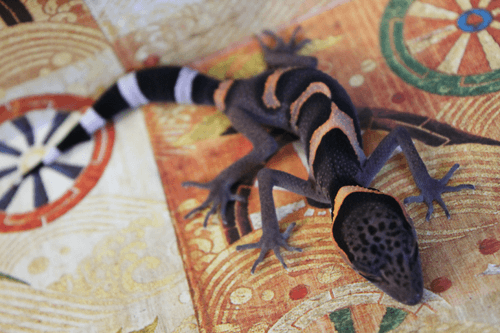
Although my first year happened in as rough a start as anyone could ask for, and looking back I shake my head at myself for the irresponsible keeping, I’ve learned a lot since then. All my animals are in separate tubs, I take great care of them and I do research all the time. I now have ten crested geckos and have started to meander about to other species that are more exciting to me and a little bit more interesting to keep. Uh, ten species total but we’ll just focus on the Goniurosaurus for now. Goniurosaurus, or cave geckos are absolutely my complete joy when it comes to geckos. There are thirteen of these species and I keep three of them: Chinese Cave Geckos (G. luii), Vietnamese Tiger Geckos (G. araneus), and of course the very popular Hainan Cave Geckos (G. hainanensis). They all have the red eyes but each looks fairly different. I started out with the Hainans like many cave gecko enthusiasts do. They are inexpensive, beautiful and I would consider them the gateway cave gecko to the rest of the thirteen species.

I saw my first cave gecko about a year and a half ago. The red fiery eyes and stark contrast of the animal caught my fancy. I had to have one. I bought my first cave gecko from Sarah over at Lunar Gecko. She started all this madness for me and jump-started me on the best journey I could have ever imagined being a part of. My first Hainan girl, Ginseng, was a ready-to-breed sized girl with retained sperm. It gave me some experience in incubating and raising baby cave geckos. The two eggs she laid both hatched successfully and both have gone to new homes already. This year we have more eggs incubating, and that experience I had from the start was extremely helpful, so I don’t feel as nervous as I might have been without it.
The set-up for an adult cave gecko is pretty simple. They like a lot of humidity and so a moisture-retaining substrate is pretty important, especially if you choose to use a tank versus a tub. My adult pair of Hainans are in a ten gallon enclosure with organic orchid bark and lots of hides. I keep the humidity at 50% at the low cycle and raise it to 90% at the high cycle when I mist at night. They also do not require a lot of heat. I keep mine at room temperature (72-79° F at my house) and they thrive in that range. Any higher than 80-82° F and these guys really don’t do well, so it’s best to keep them lower than that.
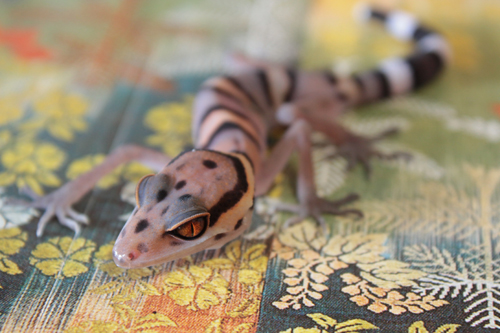
Cave geckos are an extremely shy group of geckos, with some exceptions to that rule and so need a lot of dark quiet places to hide in. I have a few live plants in the enclosure to help with humidity. Hides range from a coconut hide to an upside down flower pot dish with a hole drilled in the side for entry. Some of my juveniles also enjoy silk plants. They climb and weave through them at night. As adults, they can be housed in trios of one male to two females and you’ll often find them all hanging out in the “best” hides. These guys are also semi-arboreal. They love climbing on things with their little retractable claws. I’ve even called them Ninja Geckos before because of how much they love to climb around and get in odd places. I offer a few climbing options from branches set low in the enclosure to cork bark backgrounds. Anything in the enclosure must be secure as you wouldn’t want anything to fall onto the animal if it came loose. Although many keepers don’t supply a water dish, I do with all of my animals, just as a fail-safe. So a shallow water dish is available at all times to everyone as well as a food bowl that I toss roaches and other feeders into.
Goniurosaurus are pretty easy to keep, however the biggest thing that I’ve had to learn is to not handle them. And I don’t. It’s really a shame. For me, handling your animal is one the biggest rewards to owning them. It is the same for many other keepers I’ve run into. The only time I take these guys out is when I change substrate, weigh them and take photographs and oftentimes this all occurs on the same day to keep handling to a very low minimum. This being the case, seeing them out and about doing their little cave gecko thing is very exciting and the rush of that makes up for the fact that I cannot hold them on a daily basis. One of the most common questions I get is “Why do you have them if you can’t hold them?” The answer to that question is that I really enjoy how beautiful they are. And how mysterious they are. I’ve had quite the time digging into these shy little things. Finding out more about them and learning what many people haven’t yet documented is exciting. There are literally no weight charts, no incubation times, and practically no known information documented about these guys aside from basic care and a few tidbits here and there on forums. In the United States there are something along the lines of eight of the thirteen cave gecko species in keepers’ care that I know of. I expect to have all of them in my care within the next five years, and hope that we can see more species here in the U.S. by then. What is more exciting than having an animal in your care that you have to dig to find out about? It may not be everyone’s cup of tea, but for me it’s the best.
Carola Jucknies of www.goniurosaurus.net lives in Germany and is working as a head nurse at a hospital for Psychiatry. Since her childhood, she was interested in animals and nature and kept her first reptiles at age of 11. After a long break from keeping reptiles, she started again in 2010 with some Cordylus species.
Derek Vera is 27 years old and lives right outside of Austin, TX. He has worked in the pet industry for 12 years and enjoys educating people on the proper care of all types of pets. He currently is working with Eublepharis Macularius, Goniurosaurus Hainanensis, Paroedura Picta, and Tribolonotus Gracilis. Along with numerous other animals and reptiles, he breeds eight different species of feeder insects to sustain his collection. He established DVReptile 3 years ago to contribute to the hobby by providing high quality reptiles. https://www.facebook.com/DVReptile
Rachel Wintjen is a 25-year-old receptionist who lives on the Oregon Coast with her boyfriend, Jason, although she typically refers to herself as a gecko breeder who works to support her hobby. Ever since she was a little girl she had a passion for every kind of animal from lizards she found in the Californian deserts to birds to the burmese python her brother owned. Now, she and Jason live in a miniature zoo full of over 30 geckos, an axolotl, a ball python, one green cheek conure, a betta fish and a cat. Aside from caring for her rather large reptilian family, she is also the president of a non-profit
organization with a focus on reptile and amphibian awareness: Western Oregon Reptile Keepers.


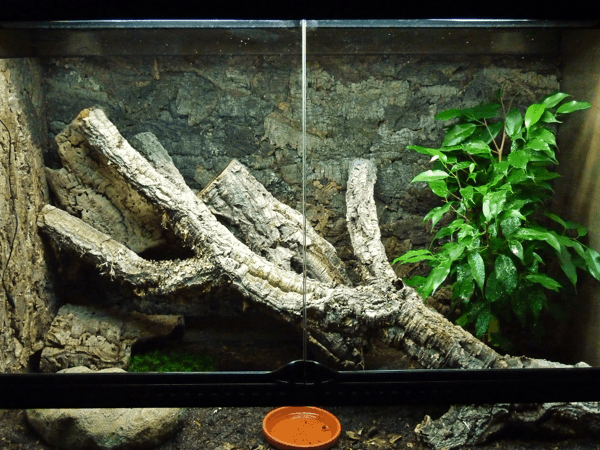
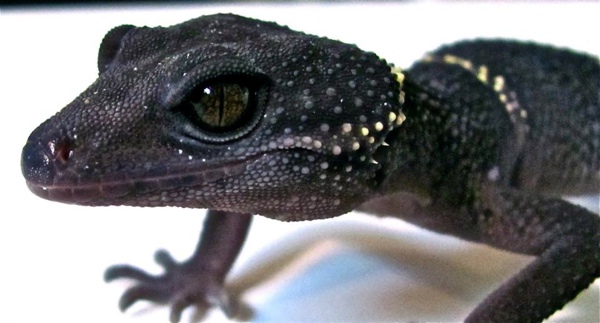
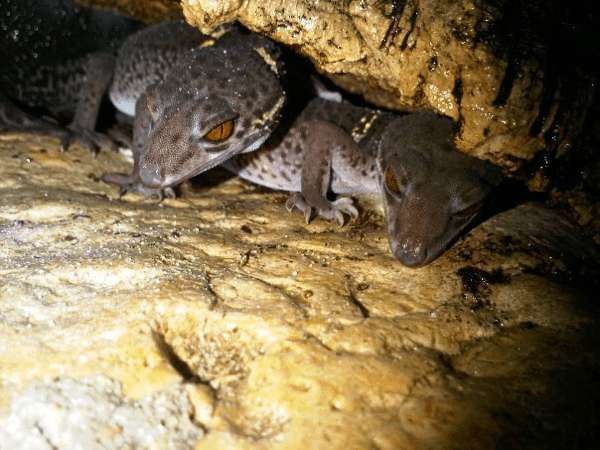
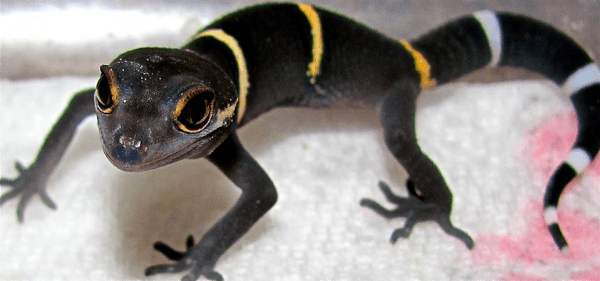
can they mate with leopard gecko?
can you breed leo and cave
No. It would be like breeding a humnan with a lemur.
Aliza
Why do you want to mate them with leos?
They are beautiful by their own.
Could you explain a little how to breed them? I have a chinese cave gecko pair and I have for about a year but no eggs yet. They are adults. I was really hoping to breed them.
I recommend you scroll down to the end of the article and contact the writers directly. Their contact info is listed in each of their bios.